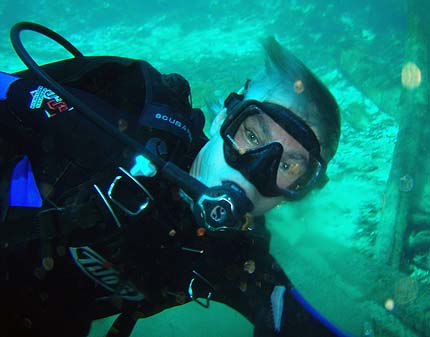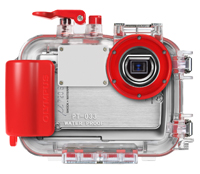« What the PADI and NAUI classes don't teach | Main | NAUI Advanced Scuba certification! »
October 26, 2006
Underwater photography
Even the most enthusiastic diver spends most of his or her life above water, and so we are used to the sights around us and the way things look on dry land. For many, the wondrous world we see beneath the surface lives as memories burned into their minds forever. Those of us who are into photography will inevitably feel a great urge to capture those sights with a camera. I am glad that I have now become comfortable enough underwater that I can take a camera along instead of being preoccupied with my equipment. It's fun, adds to the experience, and you end up with pictures of what you saw down there.
Even though I consider myself a decent photographer, and even though as co-founder of Digital Camera Magazine in 1998 and running it for eight years I have plenty of experience with all sorts of state-of-the-art photographic equipment, I quickly found that things are different underwater. As a result, I have a new appreciation for the talents of the people who shoot those wonderful, glorious pictures in our galleries here at scubadiverinfo.com and in many other places.
Last week I had an opportunity to test three cameras on a certification trip to several diving locations in Florida. The cameras I took with were not dedicated underwater equipment, just regular digital cameras that you can use near, in, and under water, with some limitations. I chose two that are inherently waterproof, the 6 megapixel Pentax Optio W10 and the 7.1 megapixel Olympus Stylus 720SW. They are sealed so you don't even need a special underwater case for them down to about 5-8 feet with the Pentax and 10-13 feet with the Olympus. That makes them perfect for snorkeling and even scuba in shallow sites. I also brought along a 7.1 megapixel non-waterproof Olympus Stylus 740 with a special deepwater case. Deepwater, in this instance, meaning it is rated waterproof down to 133 feet, the generally accepted depth limit for recreational diving.

The picture above shows that the cameras work. That's me on a training dive at Devil's Den in Williston, Florida. It was taken with the Olympus 720SW in its waterproof housing. We ended up spending hours underwater playing with the cameras. With varying success.
We did two different kinds of testing. One deepwater (down to about 70 feet, which is as far as we got on the dive sites we visited) with the waterproof cases, and one snorkeling without the cases. The latter took place during a Manatee tour where Captain Kris of Birds Underwater in Crystal River, FL expertly located some of those magnificent creatures. We used snorkeling gear to follow them and watch them grazing and gracefully gliding through the shallow waters.
Getting back to the cameras... I flooded the Pentax during that swim. It has a special safety latch to lock the rubber-sealed battery/memory card compartment door, and apparently I had forgotten to activate that. So I swam, looking down and trying to focus but the camera did not react. Instead I saw tiny bubbles come out of its speaker. Not good. I turned it around and sure enough -- the door was no longer closed tightly. I returned to the boat to assess the damage. The memory card and battery were wet and the camera clearly flooded and dead. So for the rest of the Manatee adventure we used the Olympus Stylus 720SW. Olympus chose a latch design that locks automatically, thus precluding operator error. A wise decision. The Pentax episode actually had a happy ending. Not only was I able to recover all the pictures from the wet 1GB SanDisk SD card, but after taking the Pentax apart and drying everything (not recommended for the mechanically challenged!), the Optio came back to life, working flawlessly.
 The underwater cases for the Olympus cameras are most impressive. They are made of thick, strong, clear acryllic with red seals and trim. That makes them very attractive but they are also very functional. Olympus has a dedicated case for many of their cameras, and each allows access to ALL of the hardware buttons. The buttons are different colors so that it is easier to figure out which is which underwater. Good thing, too, as the imprinted text labels on the buttons are difficult to read.
The underwater cases for the Olympus cameras are most impressive. They are made of thick, strong, clear acryllic with red seals and trim. That makes them very attractive but they are also very functional. Olympus has a dedicated case for many of their cameras, and each allows access to ALL of the hardware buttons. The buttons are different colors so that it is easier to figure out which is which underwater. Good thing, too, as the imprinted text labels on the buttons are difficult to read.
As one might expect, condensation is an issue when you go from the hot and very humid Florida climate into the cool water of a spring-fed dive site. The Olympus cases use little desiccant packages that you place inside the enclosure. There is no dedicated place for them and so they can fall out. You also need a new one every time you use the camera underwater, which can be a pain. As is, we found significant condensation even with a desiccant package. I opened the case to wipe it off, and the little package promptly fell into the water and we had to use the camera without it.
Consumer cameras that can be used underwater either with or without case usually come with a few special underwater modes. They generally include a snapshot mode, a macro mode, some wide-angle mode, and perhaps a movie mode. Neither the Pentax nor the Olympus manuals were clear on what settings the cameras used in those modes. As it turned out, the macro mode on the Olympi worked very well, rewarding us with some cool underwater close-ups. However, the wide-angle modes pretty much flopped. Neither of the two Olympus cameras tended to focus properly for us, and in low-light conditions the shutter speed seemed so slow that many shots were all blurry. And the internal flash, even with diffuser plates on the acryllic cases, illuminates scatter more than the subject. For comparison we had taken along a Reefmaster camera. It's really just an inexpensive digital camera with special underwater programming. It, having been designed for underwater use almost exclusively, proved superior.
A conference call with Olympus after the trip yielded a lot of good information. First, the obvious: even if you're the type who does not usually study the manual, when you go underwater, do. And spend a good deal of time practicing with the buttons and modes. Once under, you do not want to spend all your time pushing buttons on the camera. Second, practice with the fixed focus and autofocus modes to see what works best. Third, we had neglected to experiment with autofocus lock and digital image stabilization. Fourth, and most importantly, realize that while the Stylus 740 is a point & shooter, you can actually change settings in the modes. Using a higher ISO setting instead of leaving it on automatic would have resulted in higher shutter speed and sharper pictures. And so on. Practice is key. And I wish I could go back and try again, applying what I learned.
I have no doubt that I'll learn a lot more about underwater photography on upcoming dive trips. I also bought the PADI "Digital Underwater Photographer Manual" to see what the diving experts recommend. I do already know that bringing a camera along greatly adds to diving fun.
Posted by conradb212 at October 26, 2006 11:00 PM








